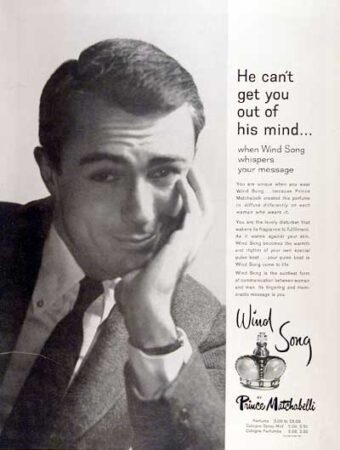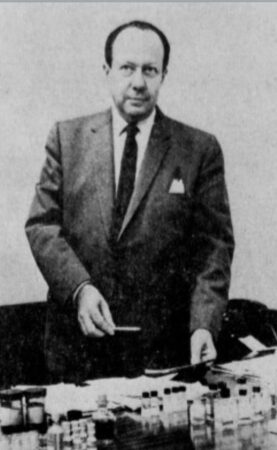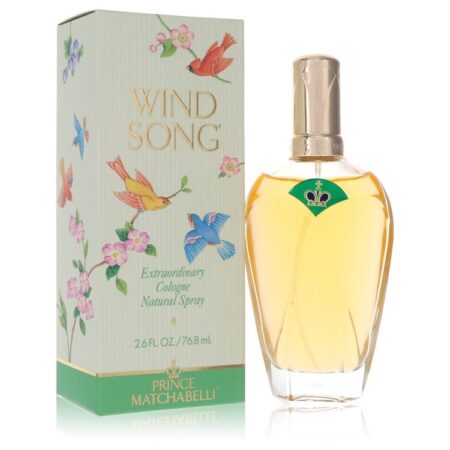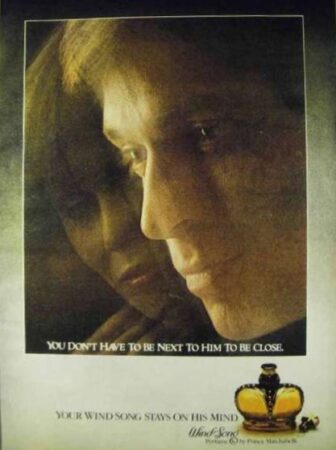
Prince Matchabelli Wind Song ad 1959 via wiki
I hope that this is common knowledge by now: you don’t have to break the bank in order to smell divine; it’s not necessary to spend a fortune. I may be an avowed vintage and unicorn perfume lover, but I love the revamped versions of fragrances one can find in your local drugstore – or for a song, online. Yes, more often than not, I’m familiar with most of the original, earlier iterations – but sometimes you have to smell fragrances without bias. This applies to what is available on the market today; these scents aren’t precisely what they were – but they have a lot of merit. It’s all too easy to deride something from the 1930s-1960s and grumble, “That’s for old ladies. It smells like old people” (hate speech is decried everywhere, but it’s permitted among perfumistas, for some reason). I choose to write about Prince Matchabelli’s (a real prince, by the way) Wind Song, because it’s a spicy woody floral created in 1953 by two famous perfumers, Ernest Shiftan, of IFF and Léon Hardy. Wind Song has earned its rightful place as a fragrance wardrobe staple: it’s exhilaratingly luscious and wearable – and you can afford it.

Perfumer Ernest Shiftan, via the Scarsdale Inquirer 1965
Little can be found regarding Léon Hardy, save brief snippets (and a brief obituary in the New York Times from 1975). Ernest Shiftan, however, was a master perfumer and senior vice president at IFF with an impressive portfolio when he took a young Sophia Grojsman under his wing. Since then, IFF have named a school after him: The Shiftan School of Scent Design and Creation, an internal perfumery school: they offer the first and only accredited program offering a Master of Science in Scent Design and Creation, in partnership with the ISIPCA (Institut supérieur international du parfum, de la cosmétique et de l’aromatique alimentaire). As this is a post-graduate course, those who apply have to have had rigorous training as a prerequisite. Mssr. Shiftan is responsible for such well-known fragrances as Brut (with Carl Mann), Révillon’s Detchéma, Jean Naté, Givenchy Le De, and Revlon Intimate, and Bat-Sheba.

Prince Matchabelli Wind Song as it looks today via various online stores
Prince Matchabelli Wind Song has gone through many hands: from Saul Ganz to Vicks Chemical Company (of Vicks Vaporub fame), to Chesebrough-Ponds (yes, that cold cream) of Unilever, and from Unilever to Parfums de Coeur in 1993. It boggles the mind. Unless you can date all the bottles accurately, it’s probably safest to assume that those available in The Vermont Country Store, Walmart, etc. – are the Parfums de Coeur versions. Parfums de Coeur has created many knock-offs (before they were called dupes) over the years – so I’ll let you draw your own conclusions. That said, in the spirit of transparency – leaves us with the bare bones of a classical floral (per Fragrances of the World expert Michael Edwards) bathed in brilliant aldehydes. Today’s Wind Song demands a little patience from its wearer, primarily because these aldehydes are so enthusiastic that they may overwhelm upon first spritz. A little time, and you are rewarded with sprightly citruses and anisic tarragon, followed by coriander’s spicy, woody sweetness tinged with lemony overtones. This piquancy is furthered by the eugenol-rich clove and carnation, peppery and saucy. The remaining floral bouquet is time-honored and true: iris, rose, ylang-ylang, and jasmine. There is nothing shy or blushing about these fragrant companions. Wind Song’s base is luxurious and welcoming, composed of so many lovely materials which soothe: my favorite rosewood, sandalwood, and cedar. A rich amber/musk collaboration nestles into the intensely sweet, balsamic benzoin with its attendant vanillic/ cinnamon facets – modulated by the smoky verdancy of vetiver as aromatic counterpoint.

Prince Matchabelli Wind Song ad 1976 via wiki
Among Wind Song’s detractors, the plaint is made that this fragrance is too brash – or too ladylike. While I can understand why some may feel this way, I find these pronouncements to be antithetical and a bit humorous: clearly, one’s mileage may vary. The real appeal of Prince Matchabelli Wind Song is that no matter how it has been altered, it remains compelling – and the drydown is well worth waiting for: plush as your favorite duvet, long-lasting and graceful. Some have drawn comparisons with Nina Ricci L’Air du Temps. As for spicy florals – well, men have loved Caron’s Poivre and Coup de Fouet, haven’t they? While Wind Song is no one’s Caron or Ricci, it’s affordable and satisfying. I don’t see why it’s exclusively feminine, even though it was marketed that way. If carnations are good enough for Oscar Wilde, they are certainly good enough for us. Enjoy, sans uncertainty!
Notes: neroli, bergamot, lemon, mandarin, coriander, orange leaf, tarragon, iris, clove, carnation, jasmine, ylang ylang, rose, rosewood, cedarwood, sandalwood, amber, musk, benzoin, vetiver. Perceived note: aldehydes
Flacon from my own collection. My nose is my own…
~ Ida Meister, Deputy and Natural Perfumery Editor
Follow us on Instagram @cafleurebonofficial @idameister
This is our Privacy Policy
